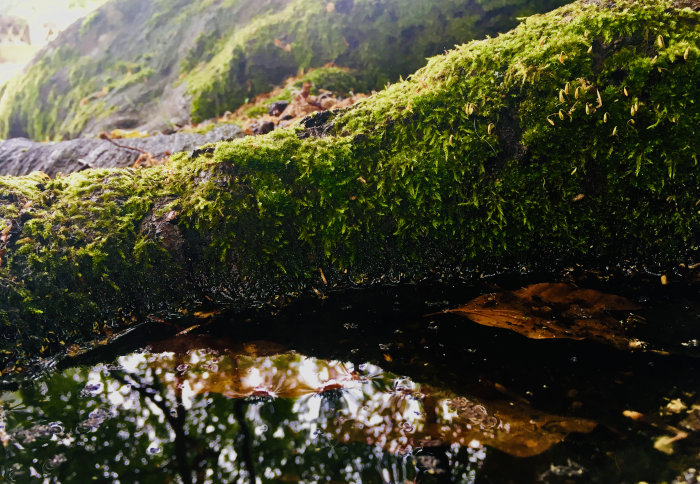For bacteria, your community determines whether you evolve or not

Puddle at the base of a beech tree
A study of puddles has shown that bacteria evolve and adapt differently depending on the make-up of the community of bacteria they live within.
The findings could have implications for better understanding how bacteria evolve resistance to antibiotics, or for modelling how beneficial communities of bacteria are likely to respond to environmental changes and global heating.
Our result shows clearly that when we want to understand how species adapt to new environments, the local community cannot be ignored. Dr Thomas Scheuerl
For example, the researchers say that to tackle bacteria that are resistant to antibiotics, scientists need to understand not just the bug causing infections, but the whole community that these bacteria live with in a person’s body.
Bacteria often live in large communities of hundreds or thousands of different species. These all interact, sometimes negatively, by competing for resources, and sometimes positively, for example when the waste from one species can be used by another.
The bacteria in the communities often need to evolve to adapt to changes, and if they are unable to adapt this can have knock-on effects for humans. For example, as lakes warm up because of global heating, the bacteria within them need to adapt and evolve.
These communities of bacteria improve water quality by breaking down organic matter, but if they can’t adapt, they will not be able to perform the valuable service of cleaning the water.
Fundamental repercussions for evolution
Because bacterial communities contain so many species, it has been difficult for scientists to uncover what drives individual species to evolve, and what determines whether they ultimately succeed or fail to adapt.
Now, in research published in Nature Communications, a team led by Imperial College London scientists have performed a unique set of experiments that have unravelled some of the mystery.
They found that the same species of bacteria evolves and adapts differently depending on the make-up of the community of bacteria they live within.
Lead researcher Dr Thomas Scheuerl, from the Department of Life Sciences at Imperial and the University of Innsbruck, said: “Bacterial communities are incredibly complex and diverse, and our study shows that how a bacterial species interacts with its community has fundamental repercussions for its evolutionary path.
“Scientists have debated how much of an effect community has on evolution, but our result shows clearly that when we want to understand how species adapt to new environments, the local community cannot be ignored.”
Drivers of evolution
Previously, scientists have tried to track the evolution of bacterial species by isolating them from their communities, or by assembling artificial communities of a few well-studied species. This was because it was considered too difficult to study real natural communities as they contain so many species.
The latest study, however, used natural communities from the puddles that collect at the bases of beech trees. These communities are relatively simple, containing on average 25-200 species.
Within each community, the team identified and partially isolated several focus species to track their evolution. They isolated the bacteria in bags used for dialysis, which separated them physically from the community in the water, but allowed them to exchange chemicals that are used as resources or to signal between cells.
They tracked 22 focal species in eight different bacterial communities, allowing them to determine which factors affected their evolution. They found that the diversity of the community – how many different species it contained and how abundant they were – was a primary driver affecting evolution.

A more diverse community meant an individual species would be less likely to evolve and adapt. The team reasoned this was because in a diverse community there were likely to be other species that could already exploit the niche better, such as using a certain resource. In a less diverse community, there would be more opportunity to take on new roles that were not already taken by other species.
The team also found that genome size (the amount of DNA a species has) and initial fitness (how fast the bacteria grow and divide under harsh conditions) were important factors influencing a species’ evolution.
Truer to life
Dr Scheuerl said: “Isolating species from their natural habitats makes them easier to study, but will remove some of the natural controls on evolution, making the results less true to life.
“The strength of our study was that we allowed multiple factors – both intrinsic to the bacteria and how it interacts with the community – to act in parallel in a situation that is very close what would be found in nature.”
Dr Damian Rivett, previously at Imperial and now at Manchester Metropolitan University, added: “Our study could have implications for example when studying antibiotic resistance. If a strain is isolated and its evolution tracked, this may be very different to how it evolves in the community inside a person’s body.”
The team now want to study more closely what factors in the community affect the evolution of individual species, and how all the species interact with each other.
-
Read more in Nature Ecology and Evolution's Behind the Paper blog.
‘Bacterial adaptation is constrained in complex communities’ by Thomas Scheuerl, Meirion Hopkins, Reuben W. Nowell, Damian W. Rivett, Timothy G. Barraclough & Thomas Bell is published in Nature Communications.
Article supporters
Article text (excluding photos or graphics) © Imperial College London.
Photos and graphics subject to third party copyright used with permission or © Imperial College London.
Reporter
Hayley Dunning
Communications Division